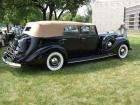|
Re: Packard info for a novice please
|
||||
|---|---|---|---|---|
|
Forum Ambassador

|
Quote:
Prewar systems were complicated with several solenoids, switches and relays to contend with. Postwar was much simpler but still one had to understand the operation to adjust it properly. I completely forgot about that. The essential differences were covered in a 1946 issue of the service newsletter, SC Vol. 22, No. 12 (p. 46). Later, an updated Serviceman's Training Booklet on Clutch and Electromatic Clutch was published. While electricals were streamlined a bit from 41 to 42, the postwar version appears to be greatly simplified. This second generation system is clearly easier to adjust with a control valve mounted, remotely, up high on the engine, but the internals looks a bit more complicated - perhaps more sensitive to wear and adjustment.
Posted on: 2014/3/16 9:58
|
|||
|
||||
|
Re: Packard info for a novice please
|
||||
|---|---|---|---|---|
|
Home away from home
|
The Commander has a 245 with a whopping 4 3/4 stroke. Very smooth, very quiet and lots of low speed torque.
Sure flathead sixes were already "old technology" by 1950, but all of those engines were very highly refined by then and provided great long-lived drivability, if not scintillating performance. That was true from Chryslers, KF, Studies and all the others. I find each of them a pleasure to drive in their own way.
Posted on: 2014/3/16 20:57
|
|||
|
||||
|
Re: Packard info for a novice please
|
||||
|---|---|---|---|---|
|
Home away from home
|
Ross, as you know, I'm new to the Packard line and hadn't heard of a Packard Commander so I googled it and found a Studebaker. Now I am following you. I love the old flatheads, simple and easy to work on. I've found that the flatheads are very dependable. All my old cars are still 6 volts and when we had days of 9 degrees this winter every one started just fine. Two of them stay outside.
Thanks for your comment Ross. Richie.
Posted on: 2014/3/16 21:19
|
|||
|
||||







